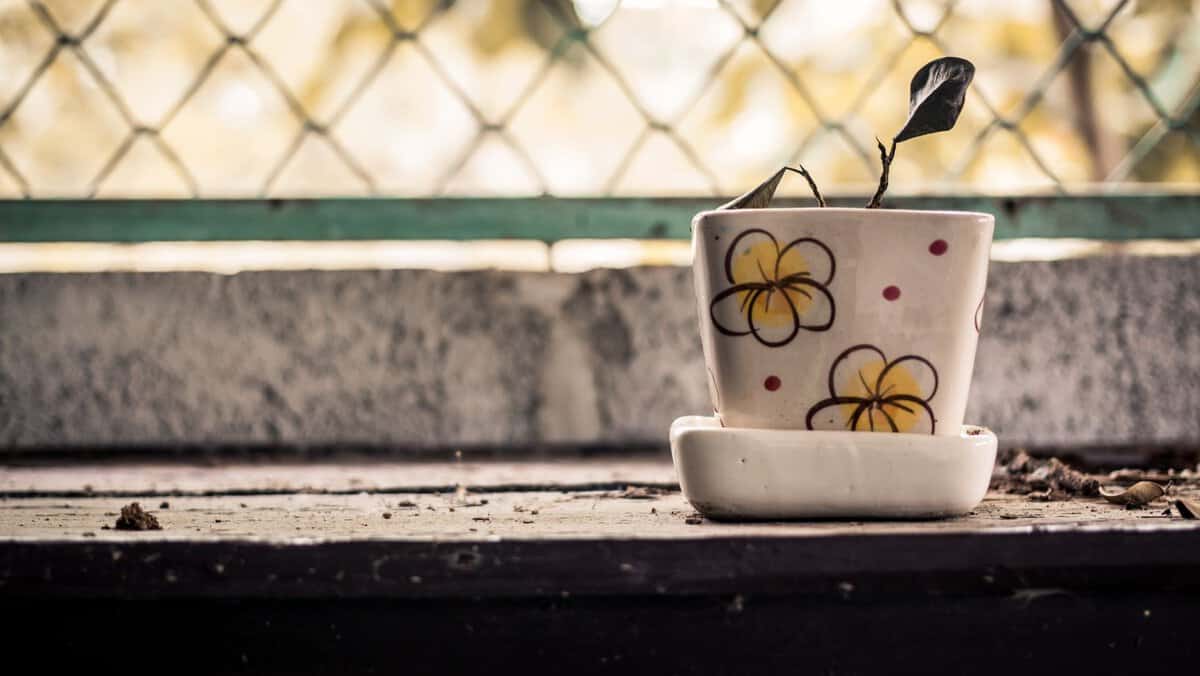Can Alocasia Survive Without Leaves? (Possible Scenarios and an Action Plan)
What happened? Spider mites? Overwatering? Underwatering? Not enough light? Too much light? Who cares? Your Alocasia has just lost her last leaf and you are checking if it is really over, or if there still is a little glimpse of hope for your plant.
I have good news for you: Alocasia can survive without leaves on one condition: that the rhizome is in good shape.
If you don’t know what a rhizome is, let’s first dig into it literally and metaphorically.
Why a healthy rhizome is a key to Alocasia survival?
Alocasias are rhizomatous plants.
When referred to Alocasias, the words ‘tubers’, ‘rhizomes’, and even ‘corms’ and ‘bulbs’ are often used interchangeably. There are numerous articles explaining the difference between those terms. I am not going into terminological details here. The important thing is that Alocasias have an underground stem whose primary function is to store nutrients necessary for the plant’s survival through the winter (or other unfavorable conditions) and growth in the following season (or when the conditions get better).
Talking about survival through the winter, Alocasias, especially larger varieties, can be grown outdoors. In hardiness zones 8-11 they can even be left outside all year round. However, in this case, the leaves naturally die out during the fall and the plant goes dormant to wake up and produce new growth in spring.
In colder areas, it is recommended to dig out and store the rhizomes indoors in winter and plant them like any other rhizomatous or tuberous plant (such as potatoes, ginger or turmeric) in spring.
The key takeaway is that your Alocasia is alive as long as her rhizome, or tuber, is alive.
Thus, the first step is to check out the rhizome.
Is Alocasia dead or simply sleeping?
First, delicately take the rhizome out of the pot. Clean off the soil and see what you’ve got. There are four possible scenarios.
Scenario #1: Rhizome is non-existent or completely rotten
If the rhizome was not large and got completely rotten, you might not even find it. Or what you find may be soft and slimy. In both cases: I am very sorry, but there is nothing to be done. Your Alocasia is dead.
Scenario #2: Dried out rhizome
If the rhizome has already consumed all or most of the nutrients that it stored, it might not have enough energy left for regrowing.
If you still want to take your chance and try to revive your Alocasia, plant the rhizome just below the surface, give it enough heat and light and spray the soil with water as soon as it is dry. Do not overwater and have patience.
I prefer to put a bare rhizome in a pot where I already have a healthy plant and try to forget about it. That way I avoid too much focus on it (you know what I mean) and it still has some attention as I take care of the host plant.
Scenario #3: Partially rotten rhizome
If a part of the rhizome is soft and mushy, while the other end is firm and fleshy, your plant can still be salvageable.
Sterilize your cutting tool and cut off the rotten parts. If you have doubts, cut it. It is better to cut a little too much than not enough, as any rot left behind will spread to the rest of the rhizome and kill it. Treat the cut edges with a fungicide (I use charcoal powder or cinnamon). And then proceed to plant the healthy rhizome.
Scenario #4: Firm and healthy rhizome
Congratulations! Your Alocasia is just a sleeping beauty.
If she fell into a deep sleep in such a radical manner (by dropping off all the leaves), it is important to understand what played the part of the spindle in your version of the fairy tale. Was it due to a lack of light? Or inadequate watering? Or spider mites?
It is good to know what cursed your Alocasia into unexpected dormancy. And you have time to figure that out and improve her growing conditions while she’s sleeping!
What to do if you break the rhizome?
Breaking the rhizome is usually not dramatic. You cannot break a rotten tuber, thus the capacity to break means the tuber is firm and juicy.

You may even end up with two plants instead of one! However, make sure to let the rhizome section dry in the air and powder the broken end with a fungicide (I usually use charcoal or cinnamon) before putting the rhizome in soil, LECA, or sphagnum. That is necessary to prevent the spread of fungi or bacteria in the exposed tissue.
One other thing to keep in mind here is that you need at least two nodes on each section of the tuber. Nodes are those places, from which shoots and roots grow. They look like rings on the rhizome. So, check that your broken pieces are big enough for propagation.
What to do with a dormant Alocasia without leaves?
Once you found out (hopefully) that your Alocasia is simply having a nap, what’s next?
If you inspected the rhizome and found it healthy, the next thing you want to do is to provide it with a nice new bed of your preferred growing medium, cover it lightly, put it in a nice warm well-lit spot, and spray or water with moderation.
Don’t think of it as salvaging, but rather as propagation. Choose the growing medium you are comfortable with. Some plant parents prefer soil, others propagate in LECA or sphagnum moss. Personally, I had some successes and failures in soil and in LECA and cannot definitely conclude that one is better than the other. Choose the one you know better.
If it’s still winter, water just enough to prevent the rhizome from drying out. When the days get longer and warmer, water a little bit more, but still in moderation. Remember: you don’t want that rhizome to rot. With a little bit of luck and a good dose of patience, you’ll see new growth.


TRUE STORY
A Story of One Wishlist Alocasia Lost to Spider Mites and Ignorance
I have one regret that seems relevant to share here. It dates back to the beginning of my aroid journey. One of my first Alocasias was a beautiful Alocasia Lauterbachiana. It was a mature plant with magnificent undulated leaves.
I adored those leaves. The problem was that spider mites did too. We spent months trying to get rid of them, but they returned every time. Older leaves were dying, but she kept growing new leaves giving me hope every time.
Then one day she dropped the last leaf and then there were none… In a moment of frustration, I just tossed the pot away. Without checking the rhizome! I am pretty sure that the rhizome was perfectly viable and today I would be able to save her.
I hope that this article saves some sleeping Alocasia from foolish and unjust tossing out.







